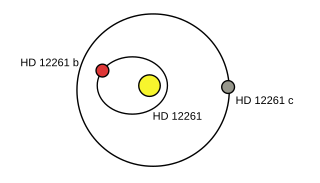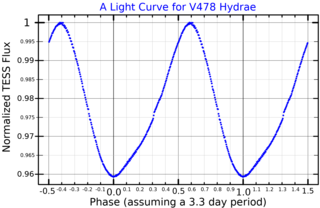
61 Cygni is a binary star system in the constellation Cygnus, consisting of a pair of K-type dwarf stars that orbit each other in a period of about 659 years. Of apparent magnitude 5.20 and 6.05, respectively, they can be seen with binoculars in city skies or with the naked eye in rural areas without light pollution.

HD 12661 is a G-type main sequence star in the northern constellation of Aries. The star is slightly larger and more massive than the Sun, with an estimated age of seven billion years. It has two known extrasolar planets.
HD 37124 is a star in the equatorial constellation of Taurus, positioned about a half degree to the SSW of the bright star Zeta Tauri. The apparent visual magnitude of this star is 7.68, which is too dim to be visible to the naked eye. It is located at a distance of 103 light years from the Sun based on parallax, but is drifting closer with a radial velocity of −23 km/s. Three extrasolar planets have been found to orbit the star.
HD 82943 is a star with a pair of orbiting exoplanets in the equatorial constellation of Hydra. It has an apparent visual magnitude of 6.54, which is near the lower limit of visibility to the naked eye. Based on parallax measurements, the distance to this system is 90.3 light years. It is drifting further away with a heliocentric radial velocity of 8.1 km/s. The star shows a high proper motion, traversing the celestial sphere at an angular rate of 0.194 arcsec yr−1.
83 Leonis, abbreviated 83 Leo, is a binary star system approximately 59 light-years away in the constellation of Leo. The primary star of the system is a cool orange subgiant star, while the secondary star is an orange dwarf star. The two stars are separated by at least 515 astronomical units from each other. Both stars are presumed to be cooler than the Sun.
HD 150706 is a star with an orbiting exoplanet in the northern constellation of Ursa Minor. It is located 92 light years away from the Sun, based on parallax measurements. At that distance, it is not visible to the unaided eye. However, with an apparent visual magnitude of 7.02, it is an easy target for binoculars. It is located only about 10° from the northern celestial pole so it is always visible in the northern hemisphere except for near the equator. Likewise, it is never visible in most of the southern hemisphere. The star is drifting closer to the Sun with a radial velocity of −17.2 km/s.
HD 40979 is a triple star system in the northern constellation of Auriga. The combined brightness of this group lies below the typical limit of visibility to the naked eye at an apparent visual magnitude of 6.74. It is located at a distance of approximately 108 light years from the Sun based on parallax. The system is receding with a radial velocity of +32 km/s. It has a relatively high rate of proper motion, traversing the celestial sphere at the rate of 0.182″ per year.
HD 73526 is a star in the southern constellation of Vela. With an apparent visual magnitude of +8.99, it is much too faint to be viewed with the naked eye. The star is located at a distance of approximately 316 light-years from the Sun based on parallax, and is drifting further away with a radial velocity of +26 km/s. It is a member of the thin disk population.
HD 20782 is the primary of a wide binary system located in the southern constellation Fornax. It has an apparent magnitude of 7.38, making it readily visible in binoculars but not to the naked eye. The system is located relatively close at a distance of 117 light-years based on Gaia DR3 parallax measurements, but it is receding with a heliocentric radial velocity of 40.7 km/s. At its current distance, HD 20782's brightness is diminished by 0.12 magnitudes due to interstellar extinction and it has an absolute magnitude of +4.61.

Theta Cygni is a star in the northern constellation of Cygnus. It has an apparent visual magnitude of 4.5, so it can be seen from the northern hemisphere with the naked eye in sufficiently dark skies. Based upon parallax measurements, it is at a distance of about 59.8 light-years from the Earth. It is suspected of hosting an extrasolar planet.

16 Cygni Bb or HD 186427 b is an extrasolar planet approximately 69 light-years away in the constellation of Cygnus. The planet was discovered orbiting the Sun-like star 16 Cygni B, one of two solar-mass (M☉) components of the triple star system 16 Cygni in 1996. It orbits its star once every 799 days and was the first eccentric Jupiter and planet in a double star system to be discovered. The planet is abundant in lithium.
HD 154345 is a star in the northern constellation of Hercules. With an apparent visual magnitude of +6.76 it is a challenge to view with the naked eye, but using binoculars it is an easy target. The distance to this star is 59.6 light years based on parallax, but it is drifting closer with a radial velocity of −47 km/s. At least one exoplanet is orbiting this star.

HD 70573 is a variable star in the equatorial constellation of Hydra. At a mean apparent visual magnitude of +8.7, this yellow-hued star is too dim to be visible to the naked eye. Based upon parallax measurements, it is located at a distance of 193 light years from the Sun, and is drifting further away with a radial velocity of 20.5 km/s. It is a candidate member of the proposed Hercules-Lyra Association of co-moving stars, although this membership is disputed.
HD 195019 is a binary star system in the northern constellation of Delphinus. The brighter star has a close orbiting exoplanet companion. This system is located at a distance of 122 light years from the Sun based on parallax measurements, but it is drifting closer with a radial velocity of −91.3 km/s. Although it has an absolute magnitude of 4.01, at that distance the system is considered too faint to be viewed with the naked eye, having a combined apparent visual magnitude of 6.87. However, it should be readily visible with a pair of binoculars or a small telescope.

Zeta Cygni is a binary star system in the northern constellation of Cygnus, the swan. It has an apparent visual magnitude of 3.26 and, based upon parallax measurements, is about 143 light-years away.
HD 4113 is a dual star system in the southern constellation of Sculptor. It is too faint to be viewed with the naked eye, having an apparent visual magnitude of 7.88. The distance to this star, as estimated by parallax measurements, is 137 light years. It is receding away from the Sun with a radial velocity of +5 km/s.
HD 79498 is a double star in the northern constellation of Cancer. The primary component of this pair has an orbiting exoplanet companion. This star is too faint to be viewed with the naked eye, having an apparent visual magnitude of 8.05. The system is located at a distance of 159 light years based on parallax measurements, and is drifting further away with a heliocentric radial velocity of 20 km/s. It has a relatively high proper motion, traversing the celestial sphere at an angular rate of 0.2″·yr−1.

29 Cygni is a single star in the northern constellation of Cygnus. It is dimly visible to the naked eye as a white-hued star with an apparent visual magnitude of 4.93. The distance to 29 Cyg, as estimated from an annual parallax shift of 24.5 mas, is 133 light years. The star is moving closer to the Earth with a heliocentric radial velocity of −17 km/s. It is a member of the 30–50 million year old Argus Association of co-moving stars.

SU Cygni is a triple star system in the northern constellation of Cygnus, abbreviated SU Cyg. The primary component of the system is a classical Cepheid variable with a period of 3.8455473 days. The changing luminosity of this star causes the system to vary in brightness from a peak apparent visual magnitude of 6.44 down to magnitude 7.22 over the course of its cycle. The distance to this system is approximately 3,200 light years based on parallax measurements. It is a member of the Turner 9 open cluster of stars.






